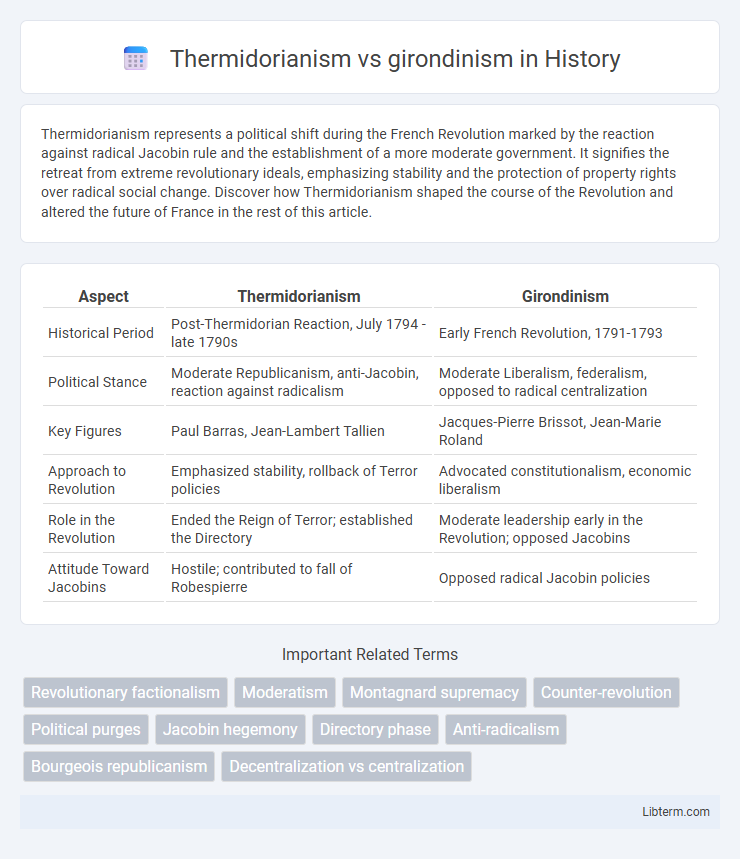Thermidorianism represents a political shift during the French Revolution marked by the reaction against radical Jacobin rule and the establishment of a more moderate government. It signifies the retreat from extreme revolutionary ideals, emphasizing stability and the protection of property rights over radical social change. Discover how Thermidorianism shaped the course of the Revolution and altered the future of France in the rest of this article.
Table of Comparison
| Aspect | Thermidorianism | Girondinism |
|---|---|---|
| Historical Period | Post-Thermidorian Reaction, July 1794 - late 1790s | Early French Revolution, 1791-1793 |
| Political Stance | Moderate Republicanism, anti-Jacobin, reaction against radicalism | Moderate Liberalism, federalism, opposed to radical centralization |
| Key Figures | Paul Barras, Jean-Lambert Tallien | Jacques-Pierre Brissot, Jean-Marie Roland |
| Approach to Revolution | Emphasized stability, rollback of Terror policies | Advocated constitutionalism, economic liberalism |
| Role in the Revolution | Ended the Reign of Terror; established the Directory | Moderate leadership early in the Revolution; opposed Jacobins |
| Attitude Toward Jacobins | Hostile; contributed to fall of Robespierre | Opposed radical Jacobin policies |
Introduction to Thermidorianism and Girondinism
Thermidorianism emerged during the French Revolution as a reaction against the radical Jacobinism, emphasizing moderation, stability, and a move away from extreme revolutionary policies following the fall of Robespierre in 1794. Girondinism, represented by the Girondins, advocated for a more federalist approach, promoting liberal ideals, constitutionalism, and political decentralization in contrast to the centralized Jacobin dominance. Both political movements reflect differing responses to revolutionary governance, with Thermidorianism favoring conservative republicanism and Girondinism pushing for moderate liberal reform.
Historical Background and Origins
Thermidorianism emerged during the Thermidorian Reaction in July 1794 as a response to the radicalism of the Jacobin-led Reign of Terror, aiming to moderate revolutionary policies and restore stability in post-Revolutionary France. Girondinism originated earlier in the French Revolution as a political faction representing the Girondins, who advocated for a constitutional government, decentralization, and war against foreign monarchies to defend revolutionary ideals. Their historical trajectories reveal contrasting approaches: Girondins emphasized liberal republicanism and federalism, while Thermidorians sought pragmatic conservatism to curb extremism and protect property rights.
Key Ideological Differences
Thermidorianism emphasized pragmatic governance and a rejection of radical revolutionary policies, advocating for stability and a return to moderate republicanism after the Reign of Terror. Girondinism championed federalism, liberal economic policies, and political decentralization, supporting war as a means to spread revolution but opposing the centralization of power seen in the Jacobin-led government. The core ideological divide centered on the Thermidorians' preference for controlled order versus the Girondins' commitment to broad democratic participation and revolutionary expansion.
Major Political Leaders and Figures
Thermidorianism was led by figures such as Paul Barras and Jean-Lambert Tallien, who aimed to curb radical Jacobin influence and stabilize post-Reign of Terror France. Girondinism was championed by leaders like Jacques Pierre Brissot and Charles Francois Dumouriez, who advocated for federalism and a more moderate republican government. These contrasting leadership styles highlighted the Thermidorians' shift towards conservative pragmatism versus the Girondins' commitment to revolutionary federalism and political liberalism.
Social and Economic Policies
Thermidorianism promoted moderate social reforms, emphasizing property rights and stability, reacting against the radical wealth redistribution of earlier revolutionary phases, while supporting a market economy with limited state intervention. Girondinism advocated for broader social equality and more aggressive economic regulation to curb aristocratic privileges, promoting agrarian reforms and support for small property owners. Both movements differed on the balance between economic liberalism and social equity, reflecting their distinct revolutionary priorities.
Role in the French Revolution
Thermidorianism marked the reaction against the radical phase of the French Revolution, leading to the fall of Robespierre and the end of the Reign of Terror, emphasizing political moderation and the restoration of bourgeois dominance. Girondinism represented the early revolutionary moderate republicanism that advocated for a constitutional government, federalism, and war against external monarchies to spread revolutionary ideals. Both factions influenced the revolution's trajectory, with Girondins pushing for broader political reforms and Thermidorians steering towards stabilizing and consolidating power after revolutionary extremism.
Attitudes Toward Violence and the Terror
Thermidorianism rejected the extreme violence and political purges characteristic of the Terror, advocating for a more moderate and stabilizing approach following Robespierre's fall. Girondinism, although initially less radical, opposed the Terror's mass executions and favored legal reforms and republican principles without endorsing widespread political repression. The Thermidorians sought to dismantle the institutions that enabled the Terror, while Girondins, marginalized earlier in the Revolution, maintained a stance against radical revolutionary violence and championed a constitutional government.
Impact on Revolutionary Governance
Thermidorianism marked a shift towards moderate policies, curbing the radicalism of the Reign of Terror and reinstating a more conservative governance structure that prioritized stability over ideological purity during the French Revolution. Girondinism emphasized federalism, war advocacy, and a commitment to bourgeois liberalism, influencing early revolutionary governance with decentralization and protection of property rights. The contrast between Thermidorianism and Girondinism significantly shaped the trajectory of revolutionary governance by balancing revolutionary zeal with pragmatic political consolidation.
Decline and Legacy of Each Faction
Thermidorianism led to the fall of Robespierre and marked the end of the Reign of Terror, ultimately paving the way for the more moderate Directory government but faced criticism for abandoning revolutionary ideals. Girondinism, associated with early revolutionary federalism and advocacy for liberal reforms, declined after purges by radical Jacobins, resulting in the loss of political influence and exile or execution of many leaders. The legacy of Thermidorianism is seen in the stabilization and conservative backlash post-Terror, while Girondinism is remembered for its promotion of parliamentary governance and resistance to extremism during the French Revolution.
Lasting Influence on Modern Political Thought
Thermidorianism shaped modern political thought by emphasizing the dangers of radical revolution and the importance of stability through moderate governance. Girondinism contributed enduring ideas on federalism and individual rights, advocating for decentralized power and liberal republican values. Both movements influenced contemporary discussions on balancing revolutionary change with institutional order to safeguard democratic principles.
Thermidorianism Infographic

 libterm.com
libterm.com